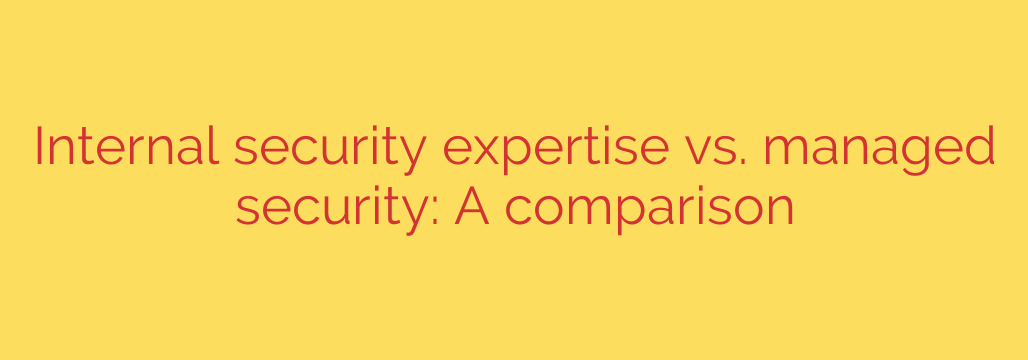
In-House vs. Managed Security: Which Cyber Defense Strategy is Right for Your Business?
In today’s digital landscape, the question isn’t if you need cybersecurity, but how you’ll implement it. As cyber threats become more sophisticated, businesses face a critical decision: build a dedicated, in-house security team or partner with a Managed Security Service Provider (MSSP)?
Both approaches offer distinct advantages and disadvantages. Choosing the right path depends on your organization’s size, budget, industry, and risk tolerance. Let’s break down the comparison to help you make an informed decision that strengthens your defenses.
The Case for an In-House Security Team
Building your own internal security department means hiring dedicated experts who work exclusively for your company. This model offers a high degree of control and integration, making it a powerful option for some organizations.
Advantages of an Internal Team
- Deep Business Integration: An in-house team develops an intimate understanding of your company’s culture, workflows, and specific assets. They know what’s normal for your network, making it easier to spot anomalies and tailor security policies that align perfectly with business goals.
- Direct Control and Customization: You have complete command over your security strategy, technology stack, and incident response protocols. This allows for highly customized security solutions designed to protect your unique environment without compromise.
- Rapid Internal Response: When a potential threat is detected or a user needs immediate assistance, your team is on-site and ready to act. This proximity can drastically reduce response times for internal issues and policy adjustments.
- Dedicated Focus: Your internal experts are 100% focused on protecting your organization. They aren’t splitting their attention across multiple clients, ensuring that your security is their top priority.
The Challenges of Building In-House
- Extremely High Costs: The biggest barrier is the expense. This includes competitive salaries for skilled professionals, benefits, ongoing training, and the high cost of enterprise-grade security tools and software. A fully-staffed team is a significant financial investment.
- The Talent Scarcity: Finding, hiring, and retaining top-tier cybersecurity talent is incredibly difficult. The demand for experts far outweighs the supply, leading to a fiercely competitive hiring market.
- Limited 24/7/365 Coverage: Cyberattacks don’t adhere to business hours. Providing round-the-clock monitoring with an in-house team requires multiple shifts, which is often prohibitively expensive and logistically complex for most businesses.
- Potential for Knowledge Gaps: No single person can be an expert in everything. An in-house team may have deep knowledge in some areas but unavoidable gaps in others, such as cloud security, threat intelligence, or specific compliance frameworks.
Exploring Managed Security Services (MSSP)
Partnering with an MSSP means outsourcing your security operations to a third-party firm. These providers offer a team of experts and advanced technology on a subscription basis, making enterprise-level security accessible to a wider range of companies.
The Benefits of Partnering with an MSSP
- Cost-Effectiveness and Predictability: An MSSP provides access to a full team of security analysts, engineers, and threat hunters for a fixed monthly or annual fee. This model eliminates the high overhead of salaries and technology procurement, turning a large capital expense into a predictable operational expense.
- Access to Specialized Expertise: MSSPs employ a diverse team of specialists with deep experience across various security domains. You instantly gain access to a broad spectrum of knowledge that would be impossible to replicate in-house without a massive budget.
- 24/7/365 Monitoring and Response: This is one of the most significant advantages. MSSPs operate Security Operations Centers (SOCs) that are staffed around the clock, ensuring that threats are detected and addressed at any time, day or night.
- Advanced Security Technology: Leading MSSPs invest heavily in the latest security tools, from threat intelligence platforms to advanced detection and response software. You benefit from this cutting-edge technology without bearing the full cost of ownership.
Potential Drawbacks to Consider
- Less Contextual Business Knowledge: While an MSSP will learn your environment, they will never have the same intrinsic understanding as a dedicated internal employee. This can sometimes lead to a slower response to nuanced, business-specific issues.
- Reliance on a Third Party: You are placing a critical business function in the hands of an external partner. It’s essential to perform thorough due diligence to ensure the MSSP is reliable, transparent, and aligned with your security goals.
- Potential for a “One-Size-Fits-Most” Approach: If not chosen carefully, some providers may offer standardized service packages that aren’t fully tailored to your unique needs. Look for a partner who is willing to customize their services.
How to Choose: Key Factors for Your Decision
So, how do you decide? Evaluate your organization based on these four critical factors:
- Budget and Financials: If your budget is constrained or you prefer a predictable operational expense, an MSSP is often the more financially viable option. If you have significant capital to invest in top talent and technology, an in-house team could be feasible.
- Company Size and Complexity: Small to medium-sized businesses (SMBs) often lack the resources to build an effective internal team, making an MSSP an ideal choice for achieving enterprise-grade security. Large enterprises with complex, bespoke systems may benefit more from a dedicated in-house team.
- Regulatory and Compliance Needs: Does your industry (e.g., healthcare, finance) have strict compliance requirements like HIPAA or PCI DSS? An MSSP with proven experience in your sector can be invaluable for navigating these complex regulations.
- Existing In-House Expertise: If you already have a strong IT team, you might consider a hybrid approach. Your internal team could manage day-to-day operations and strategy, while an MSSP handles specialized tasks like 24/7 monitoring and threat hunting. This model often provides the best of both worlds.
Your Next Step in Building a Stronger Defense
The choice between an in-house security team and an MSSP is not about which is universally “better,” but which is the right fit for your organization’s specific needs, resources, and goals. There is no one-size-fits-all answer.
The most crucial step is to move from indecision to action. Start by conducting a thorough risk assessment to understand your vulnerabilities. Whether you decide to build, buy, or blend, a proactive and well-reasoned cybersecurity strategy is no longer a luxury—it’s essential for survival.
Source: https://www.kaspersky.com/blog/xdr-or-mxdr-path/54498/








